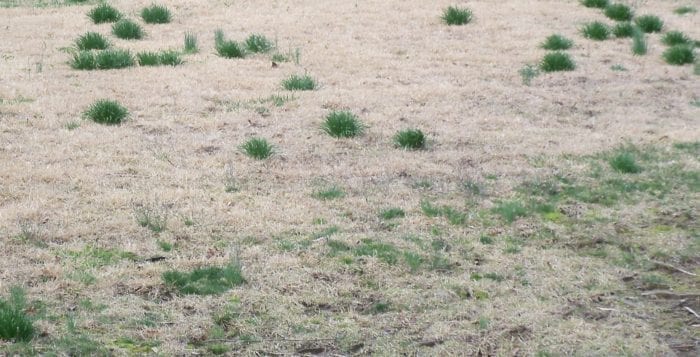Autumn is the ideal time to refresh your lawn — Part II

By Ellen Barcel
Last week, we looked at the history of lawns. Since we live in suburbia, and since lawns are part of our gardening experience, let’s take a look at what grasses we grow and what needs to be done in autumn. Each of the grasses below has its advantages and disadvantages.
Zoysia grass, a native of Asia and my personal favorite, needs little in the way of fertilizer, spreads easily through underground runners, choking out weeds, and once established is somewhat drought tolerant. Its major disadvantage is that it thrives on very warm weather, meaning that come winter, it turns brown. Some people dislike this feature enough that they will dye the brown grass green. Me, I just ignore it.
I know that come next spring it will green up and be very easy to care for, something that really appeals to me. If you do add some fertilizer in the spring, make sure you wait until the grass has actually greened up so it can take up the fertilizer. Since it is a warm-weather grass, plant it is spring, not fall.
Kentucky bluegrass is a cool-weather grass. Like zoysia grass it can spread through underground rhizomes. Being more cold tolerant, it stays nice and green much longer than other grasses. However, in the heat of summer, it needs lots of water and it’s also not very shade tolerant. Kentucky bluegrass may have been cultivated in Kentucky, but, it, too is an import from Europe and the Middle East.
Ryegrass is also a cool-weather grass. It’s a tough grass, used in sports fields. It is, however, susceptible to a variety of diseases and winterkill. It’s common in lawn seed mixes and originated in Europe, Asia and North Africa.
Fescue grass, a native of Europe, is also a cool-weather grass but has the advantage of tolerating some shade. According to Oregon State University, it was not widely planted until the 1940s and ’50s — interestingly, the time of the growth of suburbia. Because each grass has some different characteristics, you will frequently find grass seed mixes. If you notice that many of the popular grasses are cool-weather grasses, it will come as no surprise that autumn, with its cooler weather, is a great time to refurbish your lawns. You’ll have less heat and therefore require less added watering.
If you want less work, you can buy sod. Like most everything it has its advantages and disadvantages. One advantage is that it is already sprouted. Disadvantages include cost (it’s more expensive) and you don’t get to select the variety of grasses available. Sod is ideal for refurbishing small areas.
Growing from seed is more time consuming and you need to make sure the seeds are well watered. But, growing from seed is cheaper. You can also get seed that has a covering that absorbs water and contains nutrients. This latter seed is more expensive, but it’s the kind used along roadways where there is no one to tend the new planting.
Since most of the grasses in lawn mixes are cool-weather crops, they grow well in September, October and November (and even a mild December). Remember, according to Suffolk County law, you can’t add fertilizer to your lawn past the end of October. The lawns won’t take up the nutrients — they’ll go into the water table, polluting it and running off into local waterways. In spring, you can’t add fertilizer before the beginning of April for the same reason. Use pre-emergent weed killer in early spring if needed.
A soil pH of 6.0 to 7 is ideal for lawns. Since most of Long Island’s soil is substantially below this level, that is, more acidic, you need to periodically add lime to raise the pH. Read the package directions for each manufacturer’s ideal timing, frequency and amount.
Make sure you remove fallen leaves from your lawn to keep the lawn healthier. Some old-school gardeners will scatter grass seed on bare spots in their lawn just before the first predicted snow fall. This way, the seed is ready to germinate come spring. Water will be provided by the melting snow. Remember that come winter and snow, try to avoid getting ice melt on the lawn.
Cornell Cooperative Extension of Suffolk (https://ccesuffok.org) has an extensive selection of horticulture fact sheets that can be downloaded, including Healthy Lawns, Lawn Care Without Pesticides, The Homeowner’s Lawn and Repetitive Overseeding.
Ellen Barcel is a freelance writer and master gardener. To reach Cornell Cooperative Extension and its Master Gardener program, call 631-727-7850.





